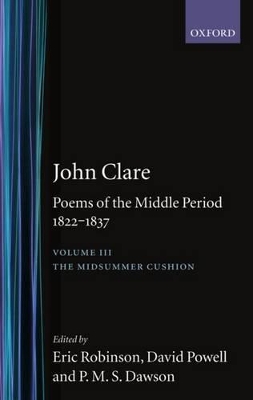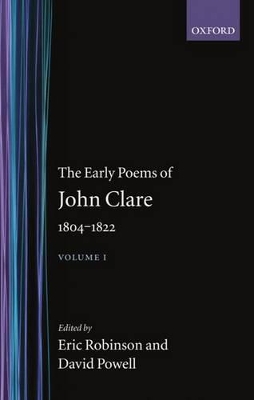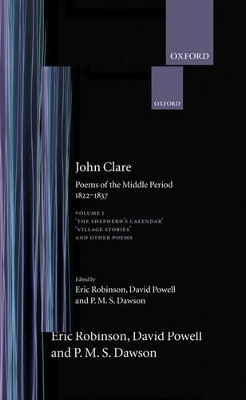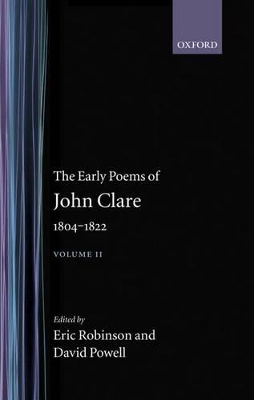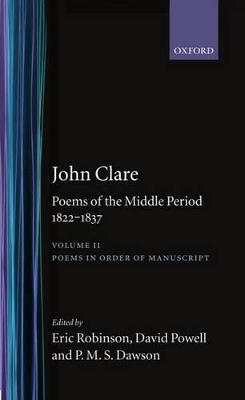Oxford English Texts: John Clare
5 total works
These volumes represent the third and fourth of five volumes devoted to Clare's 'middle period', between 1822 and 1837, arguably the years of his finest creativity. The poems contained in these volumes range from examples of Clare's satirical and political verse, in 'The Summons' and 'The Hue & Cry', to a telling expression of his philosophy of nature, in 'The Eternity of Nature', and probably the most important statement of Clare's poetic objectives in 'To the Rural Muse'. If there is any lingering belief in the 'sameness' of Clare's verse, these volumes ought surely to dispel it.
For the first time all Clare's early poems are brought together with all known variants, and with Clare's characteristic vocabulary, grammar, spelling, and punctuation preserved. Through this collection, ranging from juvenilia to the published poems that first established his reputation with Poems Descriptive of Rural Life and Scenery and The Village Minstrel, it becomes clear how many more poems Clare composed in these early years than have previously seen the light of day.
Strenuous efforts have been made to recover poems obliterated in some of Clare's first manuscripts, and the complete text of The Parish, his major satirical poem, is included. A glossary is provided for both volumes, together with extensive annotation. Clare's own dating of his first poems is employed and every attempt has been made to establish a reliable chronology.
This edition provides the first reliable basis for a new assessment of Clare's poetic growth, allowing his increasing assurance as a poet writing in a characteristic idiom of his own to be traced, and demonstrating how surprisingly early his individuality as a poet emerged.
Strenuous efforts have been made to recover poems obliterated in some of Clare's first manuscripts, and the complete text of The Parish, his major satirical poem, is included. A glossary is provided for both volumes, together with extensive annotation. Clare's own dating of his first poems is employed and every attempt has been made to establish a reliable chronology.
This edition provides the first reliable basis for a new assessment of Clare's poetic growth, allowing his increasing assurance as a poet writing in a characteristic idiom of his own to be traced, and demonstrating how surprisingly early his individuality as a poet emerged.
Clare's `The Shepherd's Calendar' has become the classic poem of English rural life and ceremony. It was accompanied, when first published, by other poems, pastorals and verse-tales, all of which appear in these two volumes, along with many others which were not selected for publication in 1827. Clare's first editors also tidied up and standardized his vocabulary, grammar and spelling, but his original language has here been restored. By the later 1820s Clare had
developed his own distinctive idiom and had adopted a more powerful voice. These volumes will make an important contribution to the ongoing assessment of Clare as a major English poet.
This is the first of five volumes devoted to Clare's `middle period', between 1822 and 1837, arguably the years of his finest creativity. These Poems of the Middle Period, which will complete the nine volume series of Clare's work, reveal the poet at his best.
developed his own distinctive idiom and had adopted a more powerful voice. These volumes will make an important contribution to the ongoing assessment of Clare as a major English poet.
This is the first of five volumes devoted to Clare's `middle period', between 1822 and 1837, arguably the years of his finest creativity. These Poems of the Middle Period, which will complete the nine volume series of Clare's work, reveal the poet at his best.
For the first time all Clare's early poems are brought together with all known variants, and with Clare's characteristic vocabulary, grammar, spelling, and punctuation preserved. Through this collection, ranging from juvenilia to the published poems that first established his reputation with Poems Descriptive of Rural Life and Scenery and The Village Minstrel, it becomes clear how many more poems Clare composed in these early years than have previously seen the light of day.
Strenuous efforts have been made to recover poems obliterated in some of Clare's first manuscripts, and the complete text of The Parish, his major satirical poem, is included. A glossary is provided for both volumes, together with extensive annotation. Clare's own dating of his first poems is employed and every attempt has been made to establish a reliable chronology.
This edition provides the first reliable basis for a new assessment of Clare's poetic growth, allowing his increasing assurance as a poet writing in a characteristic idiom of his own to be traced, and demonstrating how surprisingly early his individuality as a poet emerged.
Strenuous efforts have been made to recover poems obliterated in some of Clare's first manuscripts, and the complete text of The Parish, his major satirical poem, is included. A glossary is provided for both volumes, together with extensive annotation. Clare's own dating of his first poems is employed and every attempt has been made to establish a reliable chronology.
This edition provides the first reliable basis for a new assessment of Clare's poetic growth, allowing his increasing assurance as a poet writing in a characteristic idiom of his own to be traced, and demonstrating how surprisingly early his individuality as a poet emerged.
Poems of the Middle Period, 1822-1837: Volume II: Poems in Order of Manuscript
by John Clare
Published 25 July 1996
The additional material in this volume of poems from Clare's middle period includes some of his finest poems, such as `The Last of Summer', `The Mole Catcher' and the whole manuscript, now lost, entitled `Birds Nesting'. Clare's but his original language and usage has here been restored, his distinctive idiom and highlighting the more powerful voice evident throughout his verse written in the late 1820s. These volumes will make an important contribution to the
ongoing reassessment of Clare as a major English poet.
This is the second of five volumes devoted to Clare's `middle period', between 1822 and 1837, arguably the years of his finest creativity. These Poems of the Middle Period, which will complete the nine volume series of Clare's work, reveal the poet at his best.
ongoing reassessment of Clare as a major English poet.
This is the second of five volumes devoted to Clare's `middle period', between 1822 and 1837, arguably the years of his finest creativity. These Poems of the Middle Period, which will complete the nine volume series of Clare's work, reveal the poet at his best.
